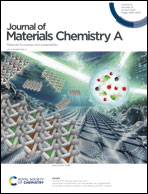Molecular engineering of polymeric carbon nitride for photocatalytic hydrogen production with ultrahigh apparent quantum efficiency†
Abstract
Polymeric carbon nitride (PCN) is promising for solar hydrogen production because of its photocatalytic response to visible light and easy fabrication. However, its photocatalytic activity is still far from expectations due to low absorption in a wide solar spectrum and strongly bound excitons. Here, we address these issues successfully by engineering PCN through the co-condensation of 2,4,6-triaminopyrimidine (TAP) and post-calcination in molten salt (NaCl + KCl). We find that the obtained samples, MCN–xTAP–NaK, show much improved optical absorption over a wide spectrum because of the activated n → π* electron transition and enhanced delocalization by introducing TAP. At the same time, the formational –C![[triple bond, length as m-dash]](https://www.rsc.org/images/entities/char_e002.gif) N and the incorporation of Na/K in MCN–xTAP–NaK can effectively promote the separation of photocarriers. As a result, MCN–xTAP–NaK achieves an excellent apparent quantum efficiency (AQE) for H2 evolution (77.8%, 29.4%, 12.1%, 1.8% and 0.5% at 450, 500, 550, 600 and 650 nm, respectively), which is much higher than the reported data. Our findings provide an insightful understanding of the photocatalytic mechanism of PCN and a new strategy for designing novel materials with efficient utilization of solar energy, which is beneficial for the development of photocatalysts for practical applications.
N and the incorporation of Na/K in MCN–xTAP–NaK can effectively promote the separation of photocarriers. As a result, MCN–xTAP–NaK achieves an excellent apparent quantum efficiency (AQE) for H2 evolution (77.8%, 29.4%, 12.1%, 1.8% and 0.5% at 450, 500, 550, 600 and 650 nm, respectively), which is much higher than the reported data. Our findings provide an insightful understanding of the photocatalytic mechanism of PCN and a new strategy for designing novel materials with efficient utilization of solar energy, which is beneficial for the development of photocatalysts for practical applications.



 Please wait while we load your content...
Please wait while we load your content...